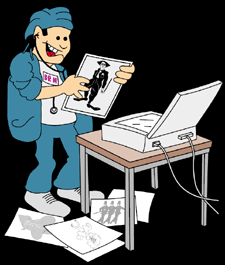|
Many comedians from the golden age of film made some
kind of parody or spoof about the movies.
Chaplin made Those Love Pangs, The Masquerader, and Behind
the Screen;
Keaton released
Sherlock Jr.;
Harold Lloyd, as Lonesome Luke, filmed Luke's Movie Muddle; and Mack
Sennett released several short subjects that poked fun at the art of movie
making. So it was only a matter of time before
Charley Chase took a stab at this subject and in Movie Night, he
really hit the high mark.
By 1929, Hollywood and the rest of the world had
resigned itself to the fact that the talking motion picture was here to stay.
Although he knew that his silent film-making days were numbered,
Charley Chase gave the world one last classic two-reeler that seemed to sum
up his long and wonderful career.
In Movie Night, Charley uses the visual
medium to "show" sound and proves, if for only a fleeting moment in the waning
days of the silents, that the art that the world had come to know and understand
was in no desperate need of being abandoned. His running gag about the
hazards of having the hiccups is pure silent comedy, despite its fundamental
roots of sound.
The basic plot concerns Charley and his family going
to the local movie house and enjoying the weekly show. From the
preparation of leaving the house, getting in line for the tickets, finding a
seat, to the final flickering image on the theater screen, this film shows any
audience from any age that nothing has really changed. However, as it's
Charley Chase going to the movies, anything that can happen, does happen.
This silent swan song is one of the funniest parodies any clown ever made.
Although he would have continued popularity in the new sound era,
Charley Chase's silents, especially the two-reelers from 1925 to 1929, are
the best examples of this all too forgotten comic genius. |
